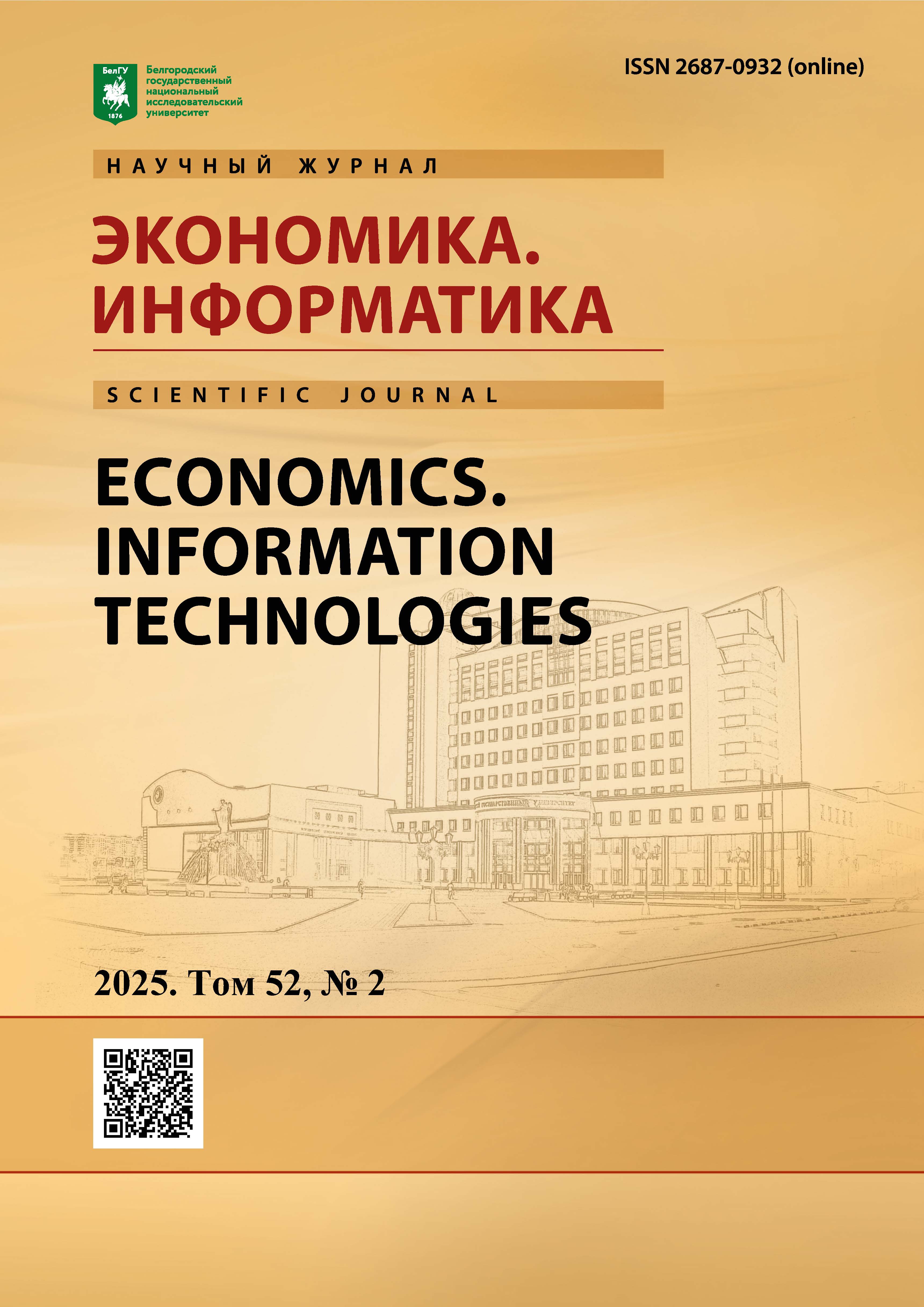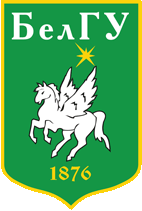Modeling the Sustainable Development of the Subjects of the Central Chernozem Macro-region in the Context of Digitalization
DOI:
https://doi.org/10.52575/2687-0932-2025-52-2-255-267Keywords:
sustainable development, regional economy, digital transformation, Central Chernozem macro-region, correlation and regression analysisAbstract
The article proposes the authors’ methodological approach based on the structure of a "smart" sustainable territory and the main directions and indicators of its assessment. It relies on the study of the evolution of approaches to modeling the sustainable development of regions, as well as on the authors’ previous findings. Five regions of the Central Chernozem macro-region were identified as the object of research. The subject of the study was the sustainable development processes in the subjects of the Central Chernozem macro-region in terms of their economic, social and environmental priorities in connection with digitalization. The authors used methods of economic and mathematical modeling, comparative, dynamic, correlation and regression analysis. The empirical base of the study was made up of materials from the statistical collection "Regions of Russia. Socio-economic indicators 2023". The calculations were performed in the Microsoft Excel data analysis package. Multi-stage checking of independent variables for multicollinearity made it possible to select the effective feature and the factorial features, to construct regression equations reflecting the former’s dependence on the latter, as well as to determine multiple correlation coefficients and the degree of the influence that the factors taken into account and those unaccounted for in the model exert on the effective feature. According to the regression equations obtained, it was found that changes in factor characteristics can have different effects on GRP per capita in the subjects of the Central Chernozem macro-region, both in the direction of relationship and in the magnitude of influence. The results obtained actualize the need to further expand the list of possible factorial and effective signs of sustainable development, to include indicators of the region’s digital infrastructure development and innovation activities into this list, to study their mutual influence and to find the optimal ratio of variables in sustainable development models to increase the explanatory and predictive capabilities of models.
Acknowledgements: the research was carried out at the expense of the grant of the Russian Science Foundation No. 23-28-01636, https://rscf.ru/project/23-28-01636/
Downloads
References
Список источников
Регионы России. Социально-экономические показатели 2023. URL: https://rosstat.gov.ru/folder/210/document/13204 (дата обращения: 14.10.2024).
Brundtland G. 1987. Our Common Future. Report of the World Commission on Environment and Development. URL: https://sustainabledevelopment.un.org/content/documents/5987our-common-future.pdf (дата обращения: 14.10.2024).
Modelling for Sustainable Development: New decisions for a new age. 2019. International Institute for Sustainable Development. https://www.iisd.org/system/files/publications/modelling-for-sustainable-development.pdf (дата обращения: 14.10.2024).
Список литературы
Алферова Т.В., Третьякова Е.А. 2024. Структурное моделирование взаимосвязей целей устойчивого развития регионов. Вестник Южно-Уральского государственного университета. Серия: Экономика и менеджмент, 18(2): 5–24. DOI: 10.14529/em240201
Антипов С.К. 2022. Моделирование устойчивого развития арктических регионов Российской Федерации (на примере Мурманской области). π-Economy, 15(6): 146–159. DOI: 10.18721/JE.15610
Лыщикова Ю.В. 2023. «Умный устойчивый город»: формирование концепции, оценка, управление. Цифровые интеллектуальные экосистемы в экономике и промышленности. Санкт-Петербург: 106–128. DOI: 10.18720/IEP/2023.5/5
Лыщикова Ю.В. 2024. Концепция «умная деревня» как новый подход к устойчивому развитию сельских территорий. АПК: экономика, управление, 3: 103–116. DOI: 10.33305/243-103
Рюмина Е.В. 2000. Анализ эколого-экономических взаимодействий. Москва. Наука, 158 с.
Форрестер Дж. В. 1978. Мировая динамика / перевод с англ. А.Н. Ворощука, С.А. Пегова ; под ред. Д.М. Гвишиани, Н.Н. Моисеева ; с предисл. Д.М. Гвишиани и послесл. Н.Н. Моисеева. Москва: Наука, 167 с.
Шимановский Д.В., Третьякова Е.А. 2020. Моделирование социо-эколого-экономических взаимосвязей как способ оценки устойчивого развития регионов РФ. Вестник Пермского университета. Серия: Экономика, 15(3): 369–384. DOI: 10.17072/1994-9960-2020-3-369-384
Antipov S. K. et al. 2020. Comparing Models of Sustainable Development for the Arctic Region of the Russian Federation. IOP Conf. Series: Earth and Environmental Science, 539: 012102. doi:10.1088/1755-1315/539/1/012102
Bolsunovskaya M.V., Kudryavtseva T.Y., Rudskaya I.A., Gintciak A.M., Zhidkov D.O., Fedyaevskaya D.E., Burlutskaya Z.V. 2023. Digital Platform for Modeling the Development of Regional Innovation Systems of Russian Federation. International Journal of Technology, 14(8): 1779–1789. https://doi.org/10.14716/ijtech.v14i8.6843
Borodin С.Н. 2023. A Model for Assessing Regional Sustainable Development Based on the Index Method. Economy of Regions, 19(1): 45–59. https://doi.org/10.17059/ekon.reg.2023-1-4
Henderson K., Loreau M. 2023. A model of Sustainable Development Goals: Challenges and opportunities in promoting human well-being and environmental sustainability. Ecological Modelling, 475, 110164. https://doi.org/10.1016/j.ecolmodel.2022.110164
Leonova T., Vinogradov L., Burylov V., Mozaleva N. 2021. Modeling Of Regions Sustainable Development Based On Digital Technologies. In I. V. Kovalev, A. A. Voroshilova & A. S. Budagov (Eds.), Economic and Social Trends for Sustainability of Modern Society (ICEST-II 2021). European Proceedings of Social and Behavioural Sciences. European Publisher, 116: 707–716. https://doi.org/10.15405/epsbs.2021.09.02.79
Marhasova V., Tulchynska S., Popelo O., Garafonova O., Yaroshenko I., Semykhulyna I. 2022. Modeling the harmony of economic development of regions in the context of sustainable development. International Journal of Sustainable Development and Planning, Vol. 17, No. 2, pp. 441–448. https://doi.org/10.18280/ijsdp.170209
Ospanov Y.A., Orazbayeva K.N., Mendebayeva A.D., Mukhametov Y.M., Sadu Zn.N. 2022. Sustainable development and environmental management of the region based on economic and mathematical modeling. Proc. SPIE 12296, International Conference on Remote Sensing of the Earth: Geoinformatics, Cartography, Ecology, and Agriculture (RSE 2022), 122960A. https://doi.org/10.1117/12.2642899
Pearce D.W., Turner R. K. 1989. Economics of Natural Resources and the Environment. JHU Press, 392 p.
Ranjula Bali Swain, Shyam Ranganathan. 2021. Modeling interlinkages between sustainable development goals using network analysis. World Development, 138, 105136. https://doi.org/10.1016/j.worlddev.2020.105136.
Rodionov D., Dianov D., Dianov S. 2022. Agent-based modelling of sustainable development of regional healthcare infrastructure. Sustainable Development and Engineering Economics 3, 3. https://doi.org/10.48554/SDEE.2022.3.3
Shamaeva E.F., Surskova E.S. 2021. Modeling the relationship between achieving the sustainable development goals on the example of the Russian Federation. SHS Web of Conferences, 128, 05015. https://doi.org/10.1051/shsconf/202112805015
Tsypkin Yu.A. et al. 2020. Strategic digital model for sustainable spatial regional development. IOP Conf. Series: Earth and Environmental Science, 579, 012138. doi:10.1088/1755-1315/579/1/012138
Tulchynska S., Popelo O., Garafonova O., Yaroshenko I., Semyhulina I. 2021. Modeling the influence of innovative factors on sustainable development of regions in the context of digitalization. Journal of Management Information and Decision Sciences, 24(8): 1–8.
Yemelina N., Omarova A., Anara K. 2018. Modelling of Sustainable Development. Journal Of Environmental Management And Tourism, 9(1): 124–129. doi:10.14505//jemt.v9.1(25).15
Zakharova E.N., Prokhorova V.V. 2015. Modeling of Sustainable Development of the Region on the Basis of Cognitive Analysis. Asian Social Science, 11(7). DOI: 10.5539/ass.v11n7p362.
References
Alferova T.V., Tretyakova E.A. 2024. Structural modeling of the interrelationships of the sustainable development goals of the regions. Bulletin of the South Ural State University. Series: Economics and Management, 18(2): 5–24. DOI: 10.14529/em240201
Antipov S.K. 2022. Modeling the sustainable development of the Arctic regions of the Russian Federation (using the example of the Murmansk region). π-Economy, 15(6): 146–159. DOI: 10.18721/JE.15610
Lyschikova Yu.V. 2023. "Smart sustainable city": concept formation, assessment, management. Digital intelligent ecosystems in the economy and industry. Saint Petersburg: 106–128. DOI: 10.18720/IEP/2023.5/5
Lyschikova Yu.V. 2024. The concept of "smart village" as a new approach to sustainable rural development. APK: economics, management, 3: 103–116. DOI: 10.33305/243-103
Ryumina E.V. 2000. Analysis of ecological and economic interactions. Moscow. Science, 158 p.
Forrester J. V. 1978. World dynamics / Translated from the English by A.N. Voroshchuk, S.A. Pegova ; Edited by D.M. Gvishiani, N.N. Moiseev; With a preface by D.M. Gvishiani and afterword by N.N. Moiseev. Moscow: Nauka, 167 p.
Shimanovsky D.V., Tretyakova E.A. 2020. Modeling of socio-ecological and economic relationships as a way to assess the sustainable development of the regions of the Russian Federation. Bulletin of the Perm University. Series: Economics, 15(3): 369–384. DOI: 10.17072/1994-9960-2020-3-369-384
Antipov S. K. et al. 2020. IOP Conf. Series: Earth and Environmental Science, 539: 012102. doi:10.1088/1755-1315/539/1/012102
Bolsunovskaya M.V., Kudryavtseva T.Y., Rudskaya I.A., Gintciak A.M., Zhidkov D.O., Fedyaevskaya D.E., Burlutskaya Z.V. 2023. Digital Platform for Modeling the Development of Regional Innovation Systems of Russian Federation. International Journal of Technology, 14(8): 1779–1789. https://doi.org/10.14716/ijtech.v14i8.6843
Borodin С.Н. 2023. A Model for Assessing Regional Sustainable Development Based on the Index Method. Economy of Regions, 19(1): 45–59. https://doi.org/10.17059/ekon.reg.2023-1-4
Henderson K., Loreau M. 2023. A model of Sustainable Development Goals: Challenges and opportunities in promoting human well-being and environmental sustainability. Ecological Modelling, 475, 110164. https://doi.org/10.1016/j.ecolmodel.2022.110164
Leonova T., Vinogradov L., Burylov V., Mozaleva N. 2021. Modeling Of Regions Sustainable Development Based On Digital Technologies. In I. V. Kovalev, A. A. Voroshilova & A. S. Budagov (Eds.), Economic and Social Trends for Sustainability of Modern Society (ICEST-II 2021). European Proceedings of Social and Behavioural Sciences. European Publisher, 116: 707–716. https://doi.org/10.15405/epsbs.2021.09.02.79
Marhasova V., Tulchynska S., Popelo O., Garafonova O., Yaroshenko I., Semykhulyna I. 2022. Modeling the harmony of economic development of regions in the context of sustainable development. International Journal of Sustainable Development and Planning, Vol. 17, No. 2, pp. 441–448. https://doi.org/10.18280/ijsdp.170209
Ospanov Y.A., Orazbayeva K.N., Mendebayeva A.D., Mukhametov Y.M., Sadu Zn.N. 2022. Sustainable development and environmental management of the region based on economic and mathematical modeling. Proc. SPIE 12296, International Conference on Remote Sensing of the Earth: Geoinformatics, Cartography, Ecology, and Agriculture (RSE 2022), 122960A. https://doi.org/10.1117/12.2642899
Pearce D.W., Turner R.K. 1989. Economics of Natural Resources and the Environment. JHU Press, 392 p.
Ranjula Bali Swain, Shyam Ranganathan. 2021. Modeling interlinkages between sustainable development goals using network analysis. World Development, 138, 105136. https://doi.org/10.1016/j.worlddev.2020.105136.
Rodionov D., Dianov D., Dianov S. 2022. Agent-based modelling of sustainable development of regional healthcare infrastructure. Sustainable Development and Engineering Economics 3, 3. https://doi.org/10.48554/SDEE.2022.3.3
Shamaeva E.F., Surskova E.S. 2021. Modeling the relationship between achieving the sustainable development goals on the example of the Russian Federation. SHS Web of Conferences, 128, 05015. https://doi.org/10.1051/shsconf/202112805015
Tsypkin Yu.A. et al. 2020. Strategic digital model for sustainable spatial regional development. IOP Conf. Series: Earth and Environmental Science, 579, 012138. doi:10.1088/1755-1315/579/1/012138
Tulchynska S., Popelo O., Garafonova O., Yaroshenko I., Semyhulina I. 2021. Modeling the influence of innovative factors on sustainable development of regions in the context of digitalization. Journal of Management Information and Decision Sciences, 24(8): 1–8.
Yemelina N., Omarova A., Anara K. 2018. Modelling of Sustainable Development. Journal Of Environmental Management And Tourism, 9(1): 124–129. doi:10.14505//jemt.v9.1(25).15
Zakharova E.N., Prokhorova V.V. 2015. Modeling of Sustainable Development of the Region on the Basis of Cognitive Analysis. Asian Social Science, 11(7). DOI: 10.5539/ass.v11n7p362.
Abstract views: 199
Share
Published
How to Cite
Issue
Section
Copyright (c) 2025 Economics. Information Technologies

This work is licensed under a Creative Commons Attribution 4.0 International License.


